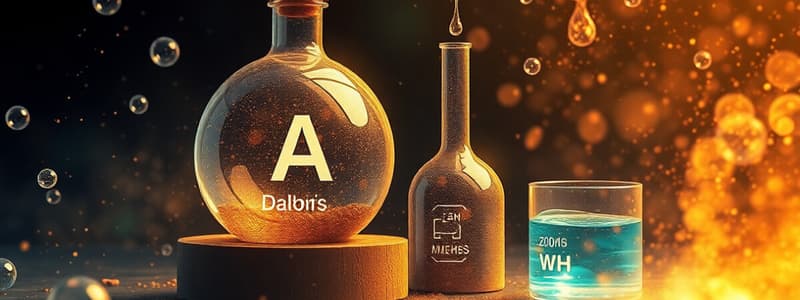Podcast
Questions and Answers
What does Dalton's law state about two elements A and B that form more than one compound?
What does Dalton's law state about two elements A and B that form more than one compound?
- The compounds can have any ratio of masses.
- The amounts of A combined with a fixed amount of B are in a small whole-number ratio. (correct)
- Only one compound can be formed between two elements.
- The total mass of A and B is always equal.
The atomic weight of hydrogen is assigned a value greater than 1.
The atomic weight of hydrogen is assigned a value greater than 1.
False (B)
What is the relative mass of one oxygen atom in comparison to hydrogen atoms?
What is the relative mass of one oxygen atom in comparison to hydrogen atoms?
16
Dalton used the _______ atom as the standard for relative atomic masses.
Dalton used the _______ atom as the standard for relative atomic masses.
Match the following elements with their assigned atomic weights:
Match the following elements with their assigned atomic weights:
What is the atomic weight of barium (Ba)?
What is the atomic weight of barium (Ba)?
One mole of any element weighs the same in grams as its atomic weight in atomic mass units.
One mole of any element weighs the same in grams as its atomic weight in atomic mass units.
How many grams of hydrogen are in 0.5 moles of H2?
How many grams of hydrogen are in 0.5 moles of H2?
Avogadro's number is equal to __________.
Avogadro's number is equal to __________.
Match the following elements with their atomic weights:
Match the following elements with their atomic weights:
Flashcards
Law of Multiple Proportions
Law of Multiple Proportions
When two elements form multiple compounds, the ratios of the masses of one element that combine with a fixed mass of the other element can be expressed in small whole numbers.
Atomic Weight
Atomic Weight
The relative mass of an atom compared to a standard, usually carbon-12.
Compound Formula
Compound Formula
A notation using element symbols and subscripts to represent the composition of a compound.
Isotopes
Isotopes
Signup and view all the flashcards
Standard Atomic Weight
Standard Atomic Weight
Signup and view all the flashcards
What is a mole?
What is a mole?
Signup and view all the flashcards
How many moles in a given mass?
How many moles in a given mass?
Signup and view all the flashcards
Calculating atoms in a sample
Calculating atoms in a sample
Signup and view all the flashcards
What is Avogadro's Number?
What is Avogadro's Number?
Signup and view all the flashcards
Carbon atoms in a diamond
Carbon atoms in a diamond
Signup and view all the flashcards
Study Notes
General Chemistry (1)
- Course offered by the Chemistry Department, Faculty of Science, Benha University.
Chapter 1: Stoichiometry
- Modern chemistry began with chemists recognizing the importance of careful measurements and quantitative analysis
- Stoichiometry is the branch of chemistry dealing with quantitative relationships between elements and compounds in chemical reactions.
- Dalton's Atomic theory is fundamental to this study.
Dalton's Atomic Theory
- Many scientists believed matter is composed of atoms.
- Dalton proposed a quantitative atomic theory:
- Elements are composed of extremely small particles called atoms. All atoms of the same element are alike, and atoms of different elements are different.
- Separation and union of atoms occur in chemical reactions. No atoms are created or destroyed, nor is an atom of one element converted into an atom of another.
- A chemical compound is formed when atoms of two or more elements combine in a simple, whole-number ratio.
- Dalton believed all atoms of a given element had equal atomic masses. (Modern knowledge suggests isotopes.)
- The theory accounts for the law of conservation of mass and the law of definite proportions.
Atomic Weights
- Dalton attempted to determine the relative masses of atoms.
- One atom of oxygen has a mass that is approximately 8 times the mass of two hydrogen atoms.
Atomic Weights
- Dalton's work involved determining relative atomic masses (atomic weights).
- Water (88.8% oxygen, 11.2% hydrogen) was used to determine approximate oxygen-to-hydrogen mass ratios.
Formulas
- Chemical symbols are used to write formulas describing compound composition.
- Molecular formulas give the number of atoms of each type in a molecule.
- Empirical formulas show the simplest whole-number ratio of atoms in a compound.
The Mole
- A mole of a substance contains Avogadro's number of units (atoms, molecules).
- The atomic weight of an element in grams is one mole.
- There are examples of calculating the number of moles and number of molecules
Derivation of Formulas
- Chemical analysis data is used to determine empirical formulas.
- The calculation is based on a 100g sample conversion of percentages to amount in grams to moles to whole number ratio for each element in the compound.
- There are examples of calculating the empirical formulas using per cent composition
Chapter 2: Atomic Structure
-
Modern atom theory has provided a foundation for modern chemistry. A key aspect is understanding atomic structure and the ways atoms interact.
-
Early experiments, including cathode ray experiments, and positive ray, provided evidence suggesting sub-atomic particles (e.g., electrons, protons.)
-
Electrons are negatively charged particles deflected in electric and magnetic fields.Their mass is much smaller than protons.
-
Thomson's e/m ratio determination of electrons was influential in understanding atoms.
-
Millikan accurately measured the charge (e) of an electron, yielding the electron's mass.
-
If electrons are removed from a neutral atom, the residue has a positive charge equal to the sum of negative charges of removed electrons.
-
Positive particles, formed in electric discharge tubes, are called positive rays.
-
Atoms consist of protons (positively charged), neutrons (uncharged), and electrons (negatively charged). Protons and neutrons are much heavier than an electron, and make up most of an atom's mass.
-
The location of protons and neutrons is the nucleus.
-
The nucleus contains most of the mass of an atom, and all the positive charge is there. Electrons exist outside the nucleus in orbitals.
-
Rutherford's gold foil experiment.
-
The neutron mass is a crucial piece for explaining atomic mass
Atomic Symbols
- Atoms are uniquely identified by their atomic number (Z, number of protons) and mass number (A, total number of nucleons)
Isotopes
- Atoms of the same element can have different mass numbers due to varying numbers of neutrons
Isobars
- Atoms of different elements can have the same mass number.
- The total number of nucleons is the same; but numbers of protons and neutrons are different
Mass Spectrometer
- An instrument for determining isotope types, accurate atomic masses, and relative abundances.
Atomic Weights
- The weighted average of the atomic masses of the natural isotopes of an element yields the atomic weight.
Chapter 3: Geometry of Chemical Molecules (Valence-Shell Electron-Pair Repulsion Theory) (VSEPR)
- Predicting the shapes of molecules
- Lewis structures as diagrams are used to represent bonding
- The VSEPR theory minimizes repulsions between valence shell electrons to determine molecule geometries.
- Examples of molecule geometries (e.g., linear, bent, pyramidal, tetrahedral, seesaw, T-shaped, octahedral) and hybridized structures, based on bonding pairs and lone pairs in simple molecules are provided with diagrams
- The number of bonding pairs
- The number of lone pairs gives the shape of the molecule
Chapter 4: Chemical Bonding
- Atoms forming stable structures by gaining, losing, or sharing electrons.
- lonic bonds result from electron transfer, creating oppositely charged ion pairs with electrostatic attractive forces.
- Covalent bonds originate from electron sharing, forming molecules with the driving force of achieving filled outer shells (octet)
- Polar covalent bonds result from unequal electron sharing, and exhibit polarity.
- Nonpolar covalent bonds result from equal electron sharing between atoms.
- Hydrogen bonds are special instances of dipole interactions in polar molecules
- Dispersion forces are temporary attractions between all molecules.
- Metallic bonds form when electrons are delocalized in a metal lattice, yielding properties observed in metals like conductivity.
Studying That Suits You
Use AI to generate personalized quizzes and flashcards to suit your learning preferences.




